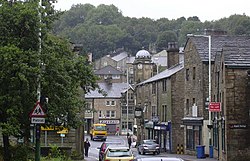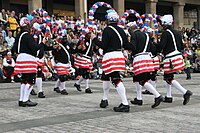Bacup
| Bacup | |
| Lancashire | |
|---|---|
 Yorkshire Street, Bacup | |
| Location | |
| Grid reference: | SD868231 |
| Location: | 53°42’14"N, 2°11’56"W |
| Data | |
| Population: | 12,763 (2001) |
| Post town: | Bacup |
| Postcode: | OL13 |
| Dialling code: | 01706 |
| Local Government | |
| Council: | Rossendale |
| Parliamentary constituency: |
Rossendale and Darwen |
Bacup is a town in Lancashire, sitting amongst the southern Pennines, close to the border with the West Riding of Yorkshire. The town sits within a rural setting in the Forest of Rossendale, amongst the steep-sided upper-Irwell Valley, through which the River Irwell passes.
Bacup is 3½ miles east of Rawtenstall, 6½ miles north of Rochdale, and 21 miles east of Preston. At the time of the 2001 Bacup and its outlying villages (including Britannia, Stacksteads, Rockcliffe, Trough Gate and Weir) had a population of 12,763.
For centuries, Bacup was a small and obscure centre of domestic flannel and woollen cloth production, and many of the original weavers' cottages survive today as listed buildings. Following the Industrial Revolution Bacup became a mill town, its landscape dominated by distinctive and large rectangular woollen and cotton mills. Bacup received a charter of incorporation in 1882, giving it borough status and its own elected town government, consisting of a mayor, aldermen and councillors to oversee local affairs.
By the late 20th century, Bacup had entered a decline, the mills closed and the town undergoing chronic depopulation and urban decay with little in the way of infrastructural change in a century.[1] Nevertheless, Bacup's historic character, culture and festivities have encouraged the town's suburbanisation and redevelopment as a commuter town; English Heritage has proclaimed Bacup as the best preserved cotton town in England, and its town centre is designated as a conservation area for its special architectural qualities.
Geography
Bacup stands just over 15 miles north-northeast of Manchester city centre, that greatest of Lancashire industrial cities, on the western slopes of the Pennine Hills, amongst the upper-Irwell Valley. The River Irwell, a 39-mile long tributary of the River Mersey, runs southwesterly through Bacup towards Rawtenstall from its source by the town's upland outskirts at Weir.[2] The Irwell is mostly culverted in central Bacup but it is open in the suburbs.[2] Bacup is roughly 1000 feet above sea level,[3] the town centre at 835 feet above sea level.[4]

Bacup is surrounded by open moor and grassland on all sides with the exception of Stacksteads at the west which forms a continuous urban area with Waterfoot and Rawtenstall. The major towns of Burnley and Accrington are to the north and northwest respectively; Walsden and Todmorden, which stands astride the border with Yorkshire are to the east; Rochdale and the conurbated towns of south Lancashire are to the south.
Areas and suburbs of Bacup include Britannia, Broadclough, Deerplay, Dulesgate, Stacksteads and Weir.[1][4]
History
The name Bacup is derived from the Old English fulbæchop, which the Oxford Dictionary of British Place Names translates as "muddy valley by a ridge". The ful- element means "foul" or "muddy" and appears in the earliest known reference to the area, in a charter by Robert de Lacey, around the year 1200, as used in the Middle English spelling fulebachope.[5] The prefix ful- was dropped from the toponym.[5] The bæchop element means either "back valley" referring to the locale's position at the back part of the Irwell Valley,[6][7] or "ridge valley".[5]
Bacup and its hinterland has provided archeological evidence of human activity in the area during the Neolithic.[8][9] Broadclough near Bacup is one of the many places suggested as the site of the Battle of Brunanburh in 937: the decisive defeat by King Æthelstan of a Norse-Scottish-Strathclyde alliance.[10]
Mediæval Bacup was an obscure and lightly populated chapelry linked with the parishes of Whalley and Rochdale, and divided between the townships of Newchurch and Spotland in the Blackburnshire. This chapelry spanned scattered hamlets and farmsteads spread across the hillsides and open moorland.
The geology and topography of the village lent itself to urbanisation and domestic industries; primitive weavers' cottages, coal pits and stonequarries were propelled by Bacup's natural supply of water power in the Early Modern period. The adoption of the factory system, which developed into the Industrial Revolution, enabled the transformation of Bacup from a small rural village into a mill town, populated by an influx of families attracted by Bacup's cotton mills, civic amenities and regional railway network. Locally sourced coal provided the fuel for industrial scale quarrying, cotton spinning and shoe making operations, stimulating the local economy. Bacup received a charter of incorporation in 1882, giving it borough status and its own elected town government, consisting of a mayor, aldermen and councillors to oversee local affairs.
Bacup's boom in textile manufacture during the Industrial Revolution resulted in the town developing into a prosperous and thickly populated industrial region|industrial area by early-20th century. The Great Depression and the ensuing deindustrialisation largely eliminated Bacup's textile processing sector and economic prosperity.
Bacup followed the regional and national trend of deindustrialisation during the early and mid-20th century; a process exacerbated by the closure of Bacup railway station in 1966. Bacup also experienced population decline; from 22,000 at the time of the United Kingdom Census 1911, to 15,000 at the United Kingdom Census 1971. Much of Bacup's infrastructure became derelict owing to urban decay, despite regeneration schemes and government funding. Shops became empty and others appeared tatty or downmarket. The houses along the main roads endured as the original terraces from Bacup's industrial age, but behind these, on the hillsides, are several council estates.[1][11][12]
Records in 2005 show Bacup to have some of the lowest crime levels in the county,[13] and the relative small change to Bacup's infrastructure and appearance has given the town a "historic character and distinctive sense of place".[1] In 2007, the murder of Sophie Lancaster attracted media attention to the town and highlighted its urban blight and lack of amenities and regeneration.[11][14][15]
Sights of the town
English Heritage has proclaimed Bacup as "the best preserved cotton town in England" and the town centre has been designated a "Conservation Area of Special Architectural and Historic Interest".[4][16][17] The majority of Bacup's culturally significant architecture is in the Victorian period, but there are older buildings of note are Fearns Hall (1696), Forest House (1815) and the 18th century Stubbylee Hall. The Bacup Natural History Society Museum was formed in 1878.
Bacup is home to the 17-foot long Elgin Street which held the record as the shortest street in the world until November 2006, when it was supplanted in this by Ebenezer Place in Wick in Caithness.[18]
Culture and community

The key date in Bacup's cultural calendar is Easter Saturday, when the Britannia Coco-nut Dancers beat the bounds of the town by a dance procession. The Britannia Coconut Dancers are a country dance troupe from Bacup whose routines are steeped in local folk tradition. They wear distinctive costumes and have a custom of blackening their faces. The origin of the troupe is claimed to have its roots in Moorish, mediæval, mining and Cornish customs.[19] The Easter Saturday procession begins annually at the Traveller's Rest Public House on the A671 road. The dancers are accompanied by members of Stacksteads Silver Band and proceed to dance their way through the streets.
Bacup Museum is local history hub and exhibition centre in Bacup. The Bacup Natural History Society was formed in 1878. The work of the society is carried out by a group of volunteers who have a base in the Bacup Museum which contains an idiosyncratic collection.
Bacup has been used as a filming location for the 1980s BBC TV police drama Juliet Bravo, Hetty Wainthropp Investigates, parts of The League of Gentlemen and much of the film Girls' Night. Elements of the BBC television adaptation of Oranges Are Not the Only Fruit were also filmed on location in Bacup.
Stacksteads is home to the World Gravy Wrestling Championships held on the late August bank holiday.
Outside links
| ("Wikimedia Commons" has material about Bacup) |
- Bacup Times - local history
References
- ↑ 1.0 1.1 1.2 1.3 'fight to get Bacup back on its feet' - Lancashire Telegraph, 24 July 2007
- ↑ 2.0 2.1 Sellers 1991, pp. 265–268.
- ↑ "Bacup, United Kingdom", Global Gazetteer, Version 2.1 (Falling Rain Genomics, Inc), http://www.fallingrain.com/world/UK/0/Bacup.html, retrieved 2009-10-28
- ↑ 4.0 4.1 4.2 Manchester City Council, Helmshore Mills, spinningtheweb.org.uk, http://www.spinningtheweb.org.uk/m_display.php?irn=242&sub=rural&theme=places&crumb=Helmshore%20Mill, retrieved 2009-10-28
- ↑ 5.0 5.1 5.2 Mills 2003, p. 28.
- ↑ Fenton 2006, p. 5.
- ↑ Cameron 1961, p. 182
- ↑ National Monuments Record: No. 45228
- ↑ National Monuments Record: No. 887154
- ↑ http://www.whitworth.gov.uk/local-info-indiv.php?id=127&name=Town_Overview Whitworth Town Council – History]
- ↑ 11.0 11.1 Hodkinson, Mark (2008-09-03), "United in the name of tolerance", The Guardian (guardian.co.uk), http://www.guardian.co.uk/uk/2008/aug/03/ukcrime.sophielancaster, retrieved 2009-11-11
- ↑ Bacup Left to Rot, rossendalefreepress.co.uk, http://www.rossendalefreepress.co.uk/news/s/507320_bacup_left_to_rot, retrieved 2009-11-11
- ↑ http://www.rossendalefreepress.co.uk/news/s/506864_bacup_crime_levels_lowest_in_county
- ↑ Korn, Helen, Bacup is the same as any town, thisislancashire.co.uk, http://www.thisislancashire.co.uk/archive/2008/04/29/Bacup+%28bacup%29/2232961.Bacup__is_the_same_as_any_town_/, retrieved 2009-11-11
- ↑ Balakrishnan, Angela (2008-10-29), "Goth murderer wins shorter sentence", The Guardian (guardian.co.uk), http://www.guardian.co.uk/uk/2008/oct/29/goth-murderer-sentence-appeal, retrieved 2009-11-11
- ↑ Rossendale Borough Council, Towns and Villages, rossendale.gov.uk, http://www.rossendale.gov.uk/tourism/site/scripts/documents_info.php?categoryID=6&documentID=353, retrieved 2009-10-27
- ↑ Freethy, Ron (2007-07-24), "Tourist guide to Bacup", Lancashire Telegraph (lancashiretelegraph.co.uk), http://www.lancashiretelegraph.co.uk/tourism/townguides/rossendale/724092.Tourist_guide_to_Bacup/?ref=rss, retrieved 2009-10-27
- ↑ 'Street measures up to new record' - BBC News, 1 November 2006
- ↑ The History of the Britannia Coconut Dancers, coconutters.co.uk, 2005, http://www.coconutters.co.uk/history.htm, retrieved 2009-11-11
- Cameron, Kenneth (1961), English Place Names, Taylor & Francis
- Terry Eagleton (1996), Heathcliff and the Great Hunger: Studies in Irish Culture, Verso, ISBN 978-1-85984-027-6
- Fenton, Mary C. (2006), Ashgate, ISBN 978-0-7546-5768-2
- Hobsbawm, Eric (1996), The Age of Capital: 1848–1875, ISBN 978-0-679-77254-5
- Lewis, Samuel (1848), A Topographical Dictionary of England, Institute of Historical Research, ISBN 978-0-8063-1508-9
- Miller, G. M. (1971), BBC Pronouncing Dictionary of British Names, Oxford University Press
- Mills, A. D. (2003), A Dictionary of British Place-Names, USA: Oxford University Press, ISBN 978-0-19-852758-9
- Sellers, Gladys (1991), Walking the South Pennines, Cicerone Press, ISBN 978-1-85284-041-9
- Shuel, Brian (1985), National Trust Guide to Traditional Customs of Britain, Webb & Bower, ISBN 0-86350-051-X
